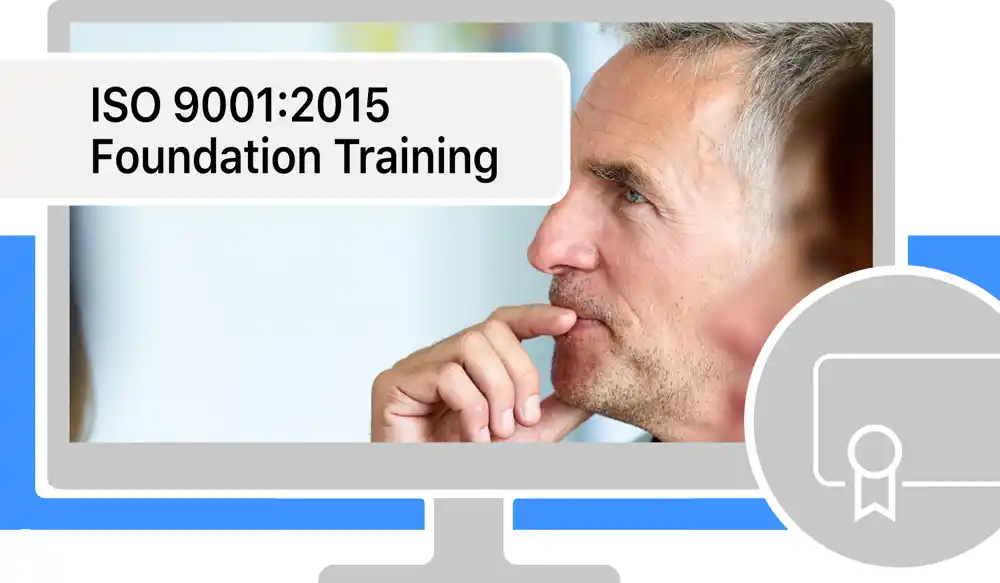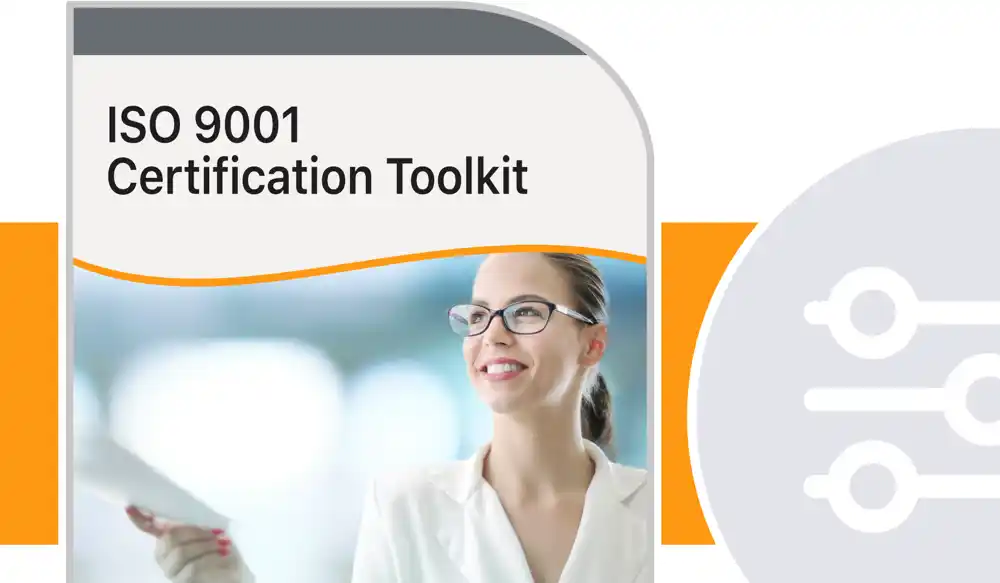What Is ISO 9001?
31 March 2025
ISO 9001 (or ISO9001) is the international standard for quality management systems (QMS), designed to help organizations improve efficiency, meet customer needs, and achieve consistent results. Published by the International Organization for Standardization (ISO), the standard is used by 1M+ businesses worldwide – yet most underutilize its potential.
This guide reveals how leading companies unlock ISO 9001’s hidden value as a strategic asset – not just a compliance requirement.
1:32


What Is ISO 9001?A Comprehensive Overview
ISO 9001 is the global benchmark for quality management, first published in 1987 by the International Organization for Standardization (ISO). Today, in its fourth revision (ISO 9001:2015), it's used by over 1 million organizations across 190 countries – from small startups to multinational corporations.
But what makes ISO 9001 so powerful? At its core, it's a framework for excellence. By implementing a Quality Management System (QMS) aligned with ISO 9001 requirements, organizations can gain powerful benefits.
Using ISO 9001:2015 helps ensure that customers get consistent, good quality products and services, which in turn brings many business benefits.
International Organization for Standardization
The Benefits and Impact of Certification
Implementing ISO 9001 isn't just about earning a certificate – it's about transforming your business. From boosting customer trust to streamlining operations, the benefits of ISO 9001 certification are far-reaching and impactful. Here's how it can make a difference for your organization:
Customer Satisfaction: Consistently Meet Expectations
Enhance customer satisfaction through consistent, high-quality deliverables that meet – or exceed – customer expectations. Meet both expressed and implied customer needs.
Improved Efficiency: Work Smarter, Not Harder
Many businesses underestimate ISO 9001's potential to streamline operations and drive bottom-line results. By identifying inefficiencies and standardizing processes, certification can help you reduce waste and rework, boost productivity by eliminating bottlenecks, and increase employee morale by eliminating friction.
Market Access & Competitive Edge: Secure Growth Opportunities
ISO 9001 certification delivers global credibility (recognized mark for bids/client trust) and meets procurement requirements (mandatory for contracts like NASA SEWP and supplier networks). Whether expanding markets or fulfilling tender prerequisites, certification unlocks doors while differentiating your business.
In short, ISO 9001 isn't just about compliance – it's a strategic tool that opens doors to new markets, builds trust with customers, and drives continuous improvement. While this overview highlights key advantages, ISO 9001 certification offers even more transformative benefits. Explore our full guide to the Top 10 Benefits of ISO 9001 Certification.
Who Benefits from ISO 9001?
ISO 9001 can be used by any organization. It's the rare standard that delivers value across industries, sectors, and organization sizes. Manufacturers reduce defects by 30-50%, while service firms boost client satisfaction. Startups gain investor credibility, and nonprofits increase funding opportunities. Even solo entrepreneurs can certify – we've helped one-person businesses succeed. Typical ROI reaches 3:1 within 18 months across industries (ISO Survey).
What Is a Quality Management System (QMS)?
At the heart of ISO 9001 lies the Quality Management System (QMS) – a structured framework that helps organizations consistently deliver high-quality products and services while meeting customer and regulatory requirements. But what exactly is a QMS, and why is it so critical?
According to the International Organization for Standardization (ISO), a QMS is a set of interconnected processes, policies, and procedures that guide an organization in achieving its quality objectives. It's not just about checking boxes or passing audits – it's about embedding quality into every aspect of your operations.
Here's how a QMS works in practice:
1. Defines Quality Objectives:
Establishes clear goals for quality, aligned with your organization's mission and customer needs.
2. Standardizes Processes:
Creates consistency by documenting and optimizing workflows across departments.
3. Monitors Performance:
Tracks key metrics to identify areas for improvement and ensure compliance with standards.
4. Drives Continuous Improvement:
Encourages a culture of learning and innovation, helping you adapt to changing market demands.
Think of a QMS as the backbone of your organization – it ensures that every team member, from leadership to frontline staff, is working toward the same quality goals. Whether you're manufacturing products, delivering services, or managing projects, a well-implemented QMS streamlines processes, reduces waste, and increases profitability.
How ISO 9001 Defines a QMS
ISO 9001 takes the concept of a QMS a step further by providing a globally recognized framework for its implementation. Under ISO 9001, a QMS is built on seven core principles – guiding philosophies that shape the standard's requirements and help organizations achieve excellence.
These Quality Management Principles aren't just theoretical; they're practical tools for driving customer satisfaction, operational efficiency, and continuous improvement. Let's explore each principle and how it can transform your business:
Customer Focus
What It Means: Understand and meet customer needs at every level of your organization.
Why It Matters: By prioritizing customer satisfaction – from initial contact to post-delivery support – you can boost loyalty, enhance product quality, and drive long-term growth.
Leadership
What It Means: Leaders must set clear quality objectives, provide resources, and lead by example.
Why It Matters: Strong leadership fosters a unified purpose and an engaged workforce, ensuring everyone is aligned with your quality goals.
Engagement of People
What It Means: Empower every employee to contribute to quality outcomes through training, support, and recognition.
Why It Matters: A motivated, competent team is essential for driving innovation and achieving consistent results.
Process Approach
What It Means: Manage interrelated activities as a coordinated system, not isolated tasks.
Why It Matters: This approach optimizes resources, reduces inefficiencies, and ensures predictable, high-quality outcomes.
Improvement
What It Means: Continuously adapt and enhance processes to respond to changing conditions.
Why It Matters: A culture of continuous improvement helps you stay competitive, reduce waste, and exceed customer expectations.
Evidence-Based Decision Making
What It Means: Use data and facts to guide decisions, rather than assumptions or intuition.
Why It Matters: Data-driven decisions reduce uncertainty, boost confidence, and support continuous improvement.
Relationship Management
What It Means: Build strong, mutually beneficial relationships with stakeholders (e.g., suppliers, partners, employees).
Why It Matters: Collaborative relationships strengthen your value chain, improve performance, and create shared success.
These seven Quality Management Principles are woven into the ten clauses of ISO 9001:2015. While the first three clauses are introductory, clauses 4–10 outline the specific requirements for implementing a Quality Management System (QMS). By aligning your QMS with these principles, you can create a culture of excellence that drives real business results.
What Is ISO 9001?Debunking 5 Common Myths
ISO 9001 is sometimes misunderstood – often because of myths that overshadow its true value. Let's set the record straight on the top misconceptions:
Myth 1: “ISO 9001 Is Only for Large Companies”
Reality: Organizations of any size – from solopreneurs to multinationals – can benefit. For example, we've helped one-person businesses achieve certification with streamlined processes as this case study demonstrates.
Myth 2: “ISO 9001 Is Only for Manufacturing”
Reality: It's successfully used by schools, hospitals, NGOs, and service firms. Our DIY Toolkit even offers industry-specific templates for easy adoption.
Myth 3: “ISO 9001 Means Excessive Paperwork”
Reality: Bureaucracy stems from poor implementation – not the standard itself. A well-designed QMS reduces paperwork by focusing on efficiency, not checkboxes.
Myth 4: “ISO 9001 Is Just for the Quality Department”
Reality: Quality is everyone's responsibility. ISO 9001 thrives when embedded company-wide – from leadership to frontline teams.
Myth 5: “Certification Is Just for Marketing”
Reality: While marketing perks are valuable, the biggest wins come from internal improvements:
30%+ efficiency gains through reduced rework and faster processes (9001Simplified client data 2004-2024)
Higher customer retention by meeting expressed and unspoken expectations
The Bottom Line
ISO 9001's impact depends on how you implement it. With the right approach, it's a growth engine – not a bureaucratic burden. Ready to cut through the noise? Our experts simplify ISO 9001. Contact us to explore your options.
What Is ISO 9001?Implementation in Practice
Core Components of an ISO 9001 QMS
ISO 9001 transforms operations through these key elements (detailed requirements here).
Clause 4: Context of the Organization
* Key Focus: Map internal/external factors
* Real-World Impact: Tech startup grew 25% faster after competitor analysis
Clause 5: Leadership
* Key Focus: Align quality with strategy
* Real-World Impact: Manufacturer reduced defects 35% with bonus-linked KPIs
Clause 6: Planning
* Key Focus: Build risk management into workflows
* Real-World Impact: Automotive supplier cut supply delays 40%
Clause 7: Support
* Key Focus: Training & documentation
* Real-World Impact: Hospital reduced errors 60% with systematic document control
Clause 8: Operations
* Key Focus: End-to-end process control
* Real-World Impact: Accounting firm eliminated 90% report delays
Clause 9: Performance Evaluation
* Key Focus: Data-driven decisions
* Real-World Impact: Logistics company saved $250K/year tracking 3 metrics
Clause 10: Improvement
* Key Focus: Learning from mistakes
* Real-World Impact: SaaS company boosted retention 15% in 6 months
Your ISO 9001 Implementation Options
Organizations typically achieve certification through one of four approaches. Your choice impacts cost, timeline, and long-term success. Read on for a summary or explore the ISO 9001 Implementation Guide.
Full-Service Consulting
Engaging a specialized consultant to manage the entire process is best for complex or time-sensitive implementations, and organizations with limited internal resources. Our experienced consultants manage the entire implementation (typical timeline is 2-3 months) and guarantee successful certification to make the process particularly stress-free.
>> Get a quotation for our convenient ISO 9001 Certification Service.
DIY with Pre-Built Kits
Utilizing a guided toolkit is best for cost-conscious small and medium sized organizations (SME) with available internal resources. Our comprehensive package doesn't require prior experience due to its suite of online and video training, step-by-step instructions, and consultant support. Typical timeline ranges from 3-6 months while allowing continued focus on day-to-day business.
>> Get started with our inexpensive ISO 9001 Certification Toolkit.
Hybrid Implementation
This approach merges our DIY toolkit with professional consultancy, presenting a cost-effective solution popular among companies striving to expedite their ISO 9001 initiatives or encountering obstacles. Complementing Do-It-Yourself implementation with the skills of an experienced consultants typically allows for stress-free certification within 2-6 months.
>> See how our Hybrid Approach could add value in your specific situation.
Build from Scratch
This option is rarely recommended as less than 12% succeed without templates/expert guidance. If you go this route, carefully study the ISO 9001:2015 standard and follow our proven 5-step certification process.
>> Start with our free ISO 9001 Implementation Checklist
We don't just get you certified – we build systems that improve how you work every day.
9001Simplified
While others treat ISO 9001 as a compliance exercise, we design business-smart systems that:
1. Eliminate Bureaucracy
2. Deliver Faster Certification
3. Generate Tangible ROI
4. Stay Relevant Long-Term
ISO 9001 Implementation Steps
While ISO 9001 implementation follows a structured approach, the process is manageable when broken into key phases. Our professional consultancies and Do-It-Yourself resources ensure successful certification based on our proven 5-step approach.
Step 1 | Preparation
Organizations establish their implementation team, define objectives, and conduct an initial gap analysis to understand current capabilities. This foundational phase ensures leadership alignment and sets realistic timelines for the project.
First steps that work:
Create enthusiasm and buy-in among employees through a brief introductory course.
Prioritize 3 "Quick Win" areas to build momentum.
Step 2 | Documentation
This phase translates ISO 9001 requirements into customized procedures that reflect actual business operations. While often the most intensive stage, focusing on essential, practical documentation rather than excessive paperwork leads to more sustainable systems.
Step 3 | Implementation
With documents finalized, the implementation phase brings these processes to life through targeted employee training and gradual operational changes, emphasizing adaptation over disruption.
Step 4 | Internal Audit
Before formal certification, an internal audit provides a vital checkpoint, verifying system effectiveness through rigorous self-assessment. This stage not only prepares organizations for their official audit but surfaces valuable improvement opportunities.
Step 5 | Certification
The culmination comes with the certification, where an accredited registrar validates compliance through a two-stage audit process, after which organizations enter a cycle of continual improvement to maintain and enhance their quality management system.
For specific tools and detailed guidance at each stage, explore our dedicated ISO 9001 Certification Process resource.
Avoiding Common ISO 9001 Pitfalls
Our analysis of 20 years of audit data reveals recurring patterns that undermine certification success. The root cause typically lies in misaligned objectives – organizations implementing ISO 9001 solely for external compliance gain fewer benefits than those pursuing genuine operational improvement.
Leadership disengagement ranks among the most critical errors. When top management delegates the entire process to quality teams without providing active direction or resources, systems often fail to deliver measurable value. Similarly, employee disengagement during implementation leads to rigid, impractical systems that ignore frontline expertise.
Many organizations also fall into the over-documentation trap, creating complex procedures that hinder rather than enable workflows. Ironically, small businesses are most vulnerable to this bureaucratic overkill. Post-certification complacency presents another risk, as systems degrade when teams revert to old habits without continuous reinforcement.
For actionable strategies to avoid these pitfalls, explore our detailed guide: Top 5 ISO 9001 Implementation Mistakes (and How to Fix Them).
Conclusion: ISO 9001 – More Than a Certificate, a Business Advantage
ISO 9001 represents the global benchmark for quality management systems, offering organizations of all sizes and industries a proven framework to enhance efficiency, boost customer satisfaction, and drive continuous improvement. As we've explored, its power lies in its flexibility – whether you're a small startup or a multinational corporation, ISO 9001 (or ISO9001) adapts to your unique operational needs.
The most successful implementations share one trait: they treat ISO 9001 not as a compliance exercise, but as a strategic tool for long-term growth. By focusing on the standard's core principles – from leadership engagement to evidence-based decision making – businesses transform quality management from a requirement into a competitive differentiator.
Ready to take the next step?
>> Explore our ISO 9001 Implementation Guide for an analysis of your implementation options
>> Still unsure? Contact our experts for a tailored approach


